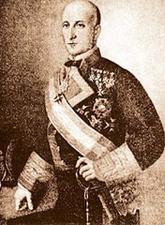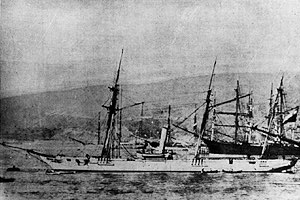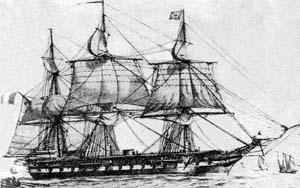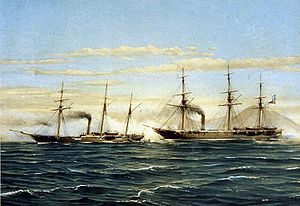
Huáscar is an ironclad turret ship owned by the Chilean Navy built in 1865 for the Peruvian government. It is named after the 16th-century Inca emperor, Huáscar. She was the flagship of the Peruvian Navy and participated in the Battle of Pacocha and the War of the Pacific of 1879–1883. At the Battle of Angamos, Huáscar, captained by renowned Peruvian naval officer Miguel Grau Seminario, was captured by the Chilean fleet and commissioned into the Chilean Navy.

The Battle of Angamos was a naval encounter of the War of the Pacific fought between the navies of Chile and Perú at Punta Angamos, on 8 October 1879. The battle was the culminating point of a naval campaign that lasted about five months in which the Chilean Navy had the sole mission of eliminating its Peruvian counterpart. In the struggle, two armored frigates, led by Commodore Galvarino Riveros Cárdenas and Navy Captain Juan José Latorre battered and later captured the Peruvian monitor Huáscar, under Rear Admiral Miguel Grau Seminario.

The Chilean Navy is the naval warfare service branch of the Chilean Armed Forces. It is under the Ministry of National Defense. Its headquarters are at Edificio Armada de Chile, Valparaiso.

Casto Secundino María Méndez Núñez was a Spanish naval officer. In late 1865, during the Chincha Islands War between Spain, Peru and Chile, he became general commander of the Spanish fleet in the Pacific. He took that post after the suicide of Admiral José Manuel Pareja on November 26, 1865, two days after the naval Battle of Papudo. As general commander, he received a promotion from Commodore to Rear Admiral.

Agustín Arturo Prat Chacón was a Chilean lawyer and navy officer. He was killed in the Battle of Iquique, during the War of the Pacific.

The Chincha Islands War, also known as Spanish–South American War, was a series of coastal and naval battles between Spain and its former colonies of Peru, Chile, Ecuador, and Bolivia from 1865 to 1879. The conflict began with Spain's seizure of the guano-rich Chincha Islands in one of a series of attempts by Spain, under Isabella II, to reassert its influence over its former South American colonies. The war saw the use of ironclads, including the Spanish ship Numancia, the first ironclad to circumnavigate the world.

The Battle of Punta Gruesa was a naval action that took place on May 21, 1879, during the War of the Pacific between Chile and Peru. This may be labelled as the second part of the Naval Battle of Iquique, although it is described in many sources as a separate battle.

Juan Williams Rebolledo was a Chilean rear admiral who was the organizer and commander-in-chief of the Chilean navy in 1879 at the beginning of the War of the Pacific. As a politician, he was elected from Valparaiso to the national Congress in 1867, and in 1873 he was elected as city councillor.

Juan José Latorre Benavente Chilean Vice Admiral, one of the principal actors of the War of the Pacific, and hero of the Battle of Angamos.

Vice Admiral José Manuel de Pareja y Septien was a Spanish naval officer, who commanded the Spanish forces during the Chincha Islands War (1864-1866).

Brigadier José Antonio de Pareja y Mariscal was a senior Spanish naval officer. He captained the Argonauta during the Battle of Trafalgar (1805) and in 1812 commanded Royalist troops during the Chilean War of Independence (1810–26).

The schooner Virgen de Covadonga, was a schooner built in Spain and launched in 1859. During the Spanish-South American War (1863-1866), it was captured by Chilean forces at the end of the Papudo naval action and incorporated into the Chilean Navy. After being assigned to exploration missions, she was later assigned to the Chilean squadron that participated in the Pacific War (1879-1883). In the Battle of Punta Gruesa defeated the Ironclad Independencia.

The Bombardment of Valparaíso on 31 March 1866 took place during the Chincha Islands War, when a Spanish fleet shelled, burned and destroyed the undefended port of Valparaíso.

BAP Apurímac was the second steam frigate of the Peruvian Navy, built in England in 1855 along with the steam schooners Loa and Tumbes as a part of a major build-up of the Navy during the government of President José Rufino Echenique. A veteran of two wars and many internal conflicts, due to her age, she served as training ship in Callao port from 1873 until January 17, 1881, when she was scuttled along with the rest of the Peruvian Navy to prevent capture by Chilean troops who had occupied the port after the defeat of the Peruvian Army in the battles of San Juan and Miraflores.

Carlos Arnaldo Condell De La Haza was a Chilean naval officer and hero of the Battle of Punta Gruesa during the start of the War of the Pacific.

Esmeralda was a wooden-hulled steam corvette of the Chilean Navy, launched in 1855, and sunk by the Huáscar on 21 May 1879 at the Battle of Iquique during the War of the Pacific.

The corvette Abtao was a wooden ship built in Scotland during 1864 of 1.600 tons and 800 IHP. She fought in the War of the Pacific and was in service for the Chilean Navy until 1922.

The Battle of Iquique was a naval engagement on 21 May 1879, during the War of the Pacific, where a Chilean corvette commanded by Arturo Prat Chacón faced a Peruvian ironclad under Miguel Grau Seminario. The battle occurred off the port of Iquique, Peru, and ended with the sinking of the Chilean wooden corvette Esmeralda by the Peruvian ironclad Huáscar after four hours of combat, marking a victory for Peru.

Juan Bravo was a Chilean Navy sailor of Mapuche origin, hero of the naval Battle of Punta Gruesa during the War of the Pacific. Juan Bravo distinguished himself in the Battle of Punta Gruesa where he, while on board the schooner Covadonga, sniped down numerous Peruvians on board the ironclad Independencia.

The action of 17 November 1865 was a minor naval engagement that took place off Tomé, during the Chincha Islands War. Chilean tugboat Independencia captured a Spanish gunboat who belonged to the frigate Resolución.




















